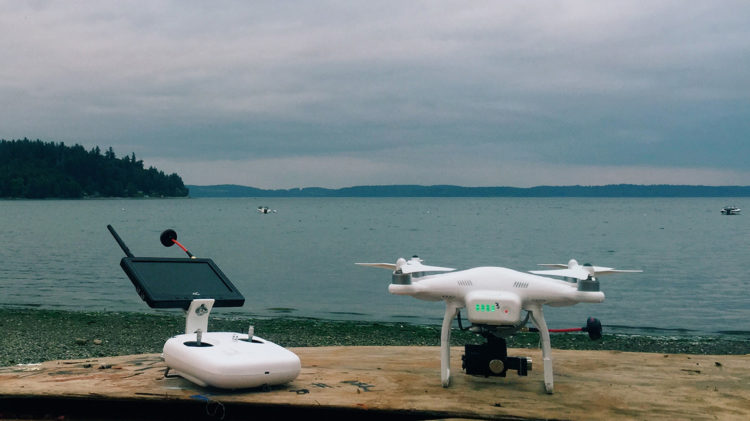Drones! Why Aren’t You Flying One Yet?
Thank you so much to Scott and Brad for having me write the guest blog this week! I feel that I should begin by being upfront with all of you and saying that, although I know that this is a photo-centric blog, and I take thousands of photographs per year, I wouldn’t consider myself a traditional photographer. All those photos that I take are turned into timelapses which end up the films that I create. Yes, I am (gasp) a filmmaker, not a photographer.
But that said, I do believe that I have something of relevance to talk about today that bridges the world of photo and video. A new tool that is capable of being used for both. I’m speaking of course, about drones: the flying cameras that will become sentient in 2030, form Skynet, and take over the world.
During the Holiday season of 2015 an estimated million drones were sold in the U.S., and this year I would expect many more to find their way under trees across the country. Some of you may already own one or be planning to purchase one soon, and I am betting that once you see how fun flying a drone can be, you’ll consider using it for aerial photography. Photographers (and filmmakers) are always looking for new angles, new lenses, new ways of seeing the world. Aerial drones offer the ability for us to see and capture moments in ways we never would have dreamt of 10 years ago.
Think of the possibilities! Landscape photography of mountains, but from 300 feet up. A newly married couple kissing in a field, as a bird overhead would see them. Panorama photos of a city, from skyscraper height. Most drones support 4K video, as well as raw photos, meaning you can now capture any moment from any elevation.
In the Summer of 2015, I had the opportunity to travel to the Pacific Northwest and film the mountains, beaches, and forests of the beautiful country there. My film “Pacific” was the result. These landscape views wouldn’t be possible in any other way.
Who Needs A Drone?
About 9 years ago, before I was even considering pursuing a career in making videos, I entered a video contest put on by Texas A&M University called “Why I’m an Aggie.” My entry featured fellow students speaking about why they chose Texas A&M and what they enjoyed about the university. Throughout the video, I featured pretty shots of campus that I shot with my trusty Sony HDR-UX1 – recording to mini-DVDs mind you, SD cards weren’t fast or large enough yet.
The shot that set my contest entry apart from the others though, was an aerial video of campus that I filmed from a plane. Yes, I actually rode in a plane over campus to get a shot for my video! This blew away the judges considering that aerial video was still relatively rare (unless you happened to have a pilot father – thanks dad).
An Aerial Video Revolution
Nearly a decade later, aerial video is now mainstream. People are buying Millennium Falcon camera drones, stuffing their dead cats and turning them into quadcopters, and anyone with a cell phone can purchase a flying camera for as little as $22 on Amazon. My aerial video in 2008 that took so much effort and timing, could now be accomplished by any kid with a drone Christmas present. Go to YouTube and search for any landmark in the world, and there is most likely an aerial video filmed of it with a drone. Do the same thing with Flickr and you’ll find nearly as many aerial photos of the same landmarks.
Due to the slow speed of government, there were several years where drones were allowed to be flown nearly anywhere. Half Dome in Yosemite, the Eiffel Tower in Paris, the Taj Mahal in India, and many more places around the world required no permission, red-tape, or license to fly. People were starting to see things from an entirely different perspective, and getting a bird’s eye view was becoming downright cheap. In addition, there were no requirements for commercial use; meaning anyone could fly a drone and be paid for it.
Playing catch-up in 2012, the Federal Aviation Administration (FAA) passed the FAA Modernization and Reform Act. Under section 333 of this act, the FAA was now in charge of regulating commercial drone usage in the United States. With no way for drone pilots to fly their drones legally for commercial usage, many of them chose to ignore this rule and continue to make money.
Time For Safety And Order
This “wild west” of drone flying continued until May 2014, when the FAA began accepting petitions of exemption for Section 333. Any pilot could fill out some paperwork stating their business, why they wanted to fly a drone, and how they would be safe while doing it. Within 120-ish days, the FAA would reply with (hopefully) a grant of exemption allowing these pilots to fly a drone legally for commercial use. This exemption came with one HUGE caveat though, the person operating the drone must possess, at minimum, a private pilot’s license.
Yes, if you wanted to fly a small plastic drone the size of a shoebox commercially, the FAA expected you to know how to fly a full sized plane. This requirement led to greater attendance at many flight schools across the country, and also resulted in people exploiting loopholes such as getting their hot air balloon license. If you thought knowing how to fly a full sized plane didn’t apply much to knowing how to fly a tiny drone, try dangling from a basket suspended under two tons of canvas, air, and fire. Speak to many drone pilots from the “section 333” years though, and most of them ignored the rules and flew without a waiver.
Thankfully, the Section 333 exemption process was merely a band-aid while the FAA finalized their official rules for commercial drone usage. Finally, two years later in August of 2016, the FAA passed Part 107 of the Federal Aviation Regulations – rules that govern the usage of small unmanned aircraft (aka drones). These rules were far more comprehensive than Section 333, did not require a petition letter, and most importantly, did not require an actual pilot’s license to fly a drone commercially.
Tests? I Hate Tests…
This massive drop in requirements from Section 333 to Part 107 made a lot of sense. Someone at the FAA realized that drones were not planes, and they shouldn’t require the exact same certification of their pilots. Drones are smaller, slower, and significantly easier to fly than a full sized plane, but below the surface, there are still many similarities between the two.
Both planes and drones are at the mercy of the weather, and no pilot of plane or drone should fly through a thunderstorm. Concepts such as center of gravity and g-forces apply to an aircraft no matter the size. Different classes of airspaces around airports exist to keep tabs on all aircraft in their vicinity, and keep pilots safe. These similarities, as well as many more, are why the FAA requires drone pilots under Part 107 to pass a knowledge test to become certified commercial pilots.
As someone that finished college five years ago, and has subsequently structured their life so they don’t have to take any more tests (or wear a tie for that matter), I was not excited about the prospect of taking a test. But, faced with the alternative of hanging up my drone for anything except fun unpaid videos in my backyard, I knew I would need to take it and pass.
How To Study For The Test…
We’ve now arrived at the main point of this blog post: a video I created which is all about why you should take the knowledge test, and how to study for and pass it. In the video, I detail the exact (free!) resources that I used to pass the Part 107 knowledge test.
If you find that self studying isn’t for you and a classroom setting works better, I would recommend checking out Remote Pilot 101 and Drone Pilot Ground School. Both offer classes with videos, articles, and teachers that are willing to answer any questions you have.
But if you’re like me and you have a month or two to study in your spare time, I would recommend the following resources. You can read them below in the order I spoke about them in the video:
BASIC DRONE KNOWLEDGE
PART 107 TEST COURSES & CLASSES
AMERICAN FLYER’S TESTING CENTERS
FAA OFFICIAL STUDY GUIDE
FAA Advisory Circular
SECTIONAL CHARTS VIDEOS
FAA TEST SUPPLEMENT BOOKLET
COMMERCIAL DRONES FM PODCAST EPISODE 6
- Test Prep and Study Guide for Drone Pilots (scroll to episode 6 in the player window)
FAA PART 107 PRACTICE TEST
JONATHAN RUPPRECHT FAA PART 107 PRACTICE TEST ANSWERS & STUDY GUIDE
3D ROBOTICS PART 107 PRACTICE TEST
OTHER RESOURCES NOT MENTIONED IN THE VIDEO
That’s it! Read and study these articles, listen to the podcast, take the practice test, and when you’re ready, go and take the real thing. If you take your time and prepare, you’ll pass like I did.
Is It All Worth It?
After having spent a month and a half studying, reading pages of material, and fully immersing myself in sectional charts, weather reports, and drone knowledge, I would say that it is completely worth it. There wasn’t a single bit of knowledge that I studied for this test that I didn’t find useful in some way. I know now that I am a more well prepared pilot, and that I will handle my drone safer than I would have before. I hope this study guide is helpful to you and has opened your eyes to the world of drone filmmaking and photography.
If you have any questions about drones, timelapses, or any other aspects of filmmaking, feel free to get in touch!
You can see more of Matt’s work at WhoIsMatt.com, and follow him on Instagram, Facebook, Twitter, Vimeo, and YouTube.







I’m a drone flyer, and currently studying for the part 107 test. This should not be understated, there is a ton of material and it’s a serious commitment in time. My neighbor works for the FAA and he’s offered me lots of valuable guidance, but he warns – the pervasive amount of drones has the FAA’s full attention now. It’s going to get much tougher to fly for everyone. The number of drones has increased exponentially in a very short time. And, too many drone pilots don’t know enough and don’t follow the rules. Flying in airspace where they shouldn’t be or not maintaining a flight and maintenance log, it’s only a matter of time before someone gets hurt, causes damage or disruption. I don’t have a crystal ball, but if the amount of drones continue at this pace, the reality is we may see them become very restricted or possibly banned entirely.
I completely agree with you about the FAA increasing drone restrictions Ivan. I could see them putting more rules down to keep people from doing dumb things with them. That said, I doubt they would ever be banned fully, they are far too useful and the government is already making money off them. :)
I’m hoping that during the year end evaluation the FAA will ease a couple rules. The 107 is tough, lots of tricky questions but I passed.
I have the P4P+, Mavic and Inspire Pro (Inspire 2 on it’s way)! Love the drones, I also have my 107, such a great new way to photograph!!!!
You have the fleet that I dream that I had! Lol
The new screen that comes with P4P+ is awesome, no hood ever needed! I’ll be getting the new CrystalSky Tablet when DJI releases.